Market Research Proposal: IATA's Environmental Perception Study
VerifiedAdded on 2022/08/16
|22
|4933
|12
Report
AI Summary
This market research proposal, prepared for the International Air Transport Association (IATA), addresses the growing consumer concern regarding the environmental impact of air travel, often referred to as 'flygskam'. The study aims to understand consumer perceptions of airline carbon emissions and explore whether these perceptions vary among different traveler types (business, leisure, student). The proposal outlines a quantitative research approach, involving surveys of 1000 passengers each from Delta Air Lines and Alaska Air, to gather primary data on consumer awareness and attitudes. Secondary research provides background on the airline industry's environmental impact and existing mitigation strategies. The research objectives include assessing the environmental image of member airlines, identifying the influence of passenger types, and evaluating the effectiveness of eco-friendly initiatives such as carbon offsetting and reduced plastic use. The proposal details the research methodology, including the data collection method, sample size, data analysis techniques, timeline, and budget. The ultimate goal is to provide IATA with actionable insights to improve the airlines' environmental image and develop effective marketing strategies to address consumer concerns and promote sustainable aviation practices.
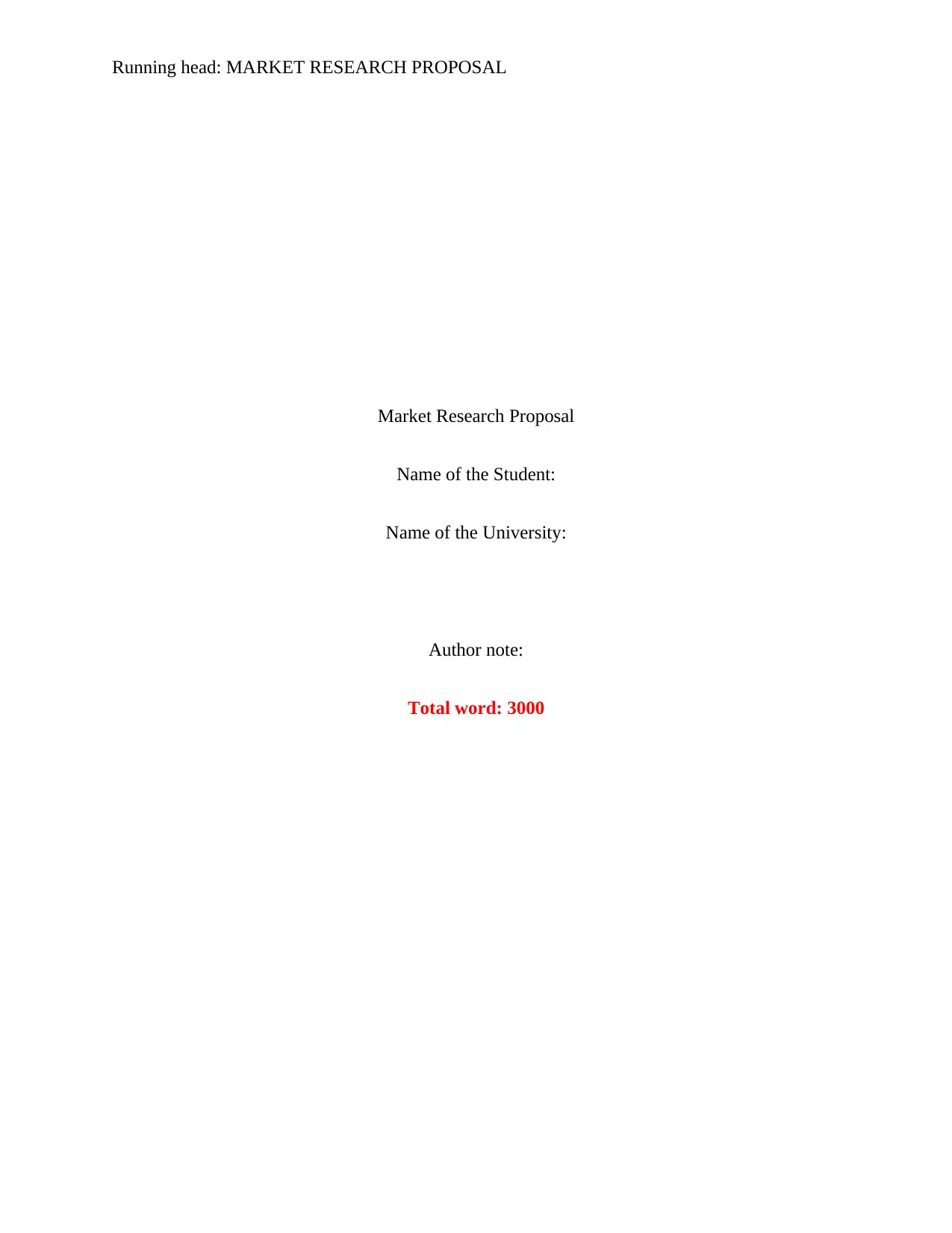
Running head: MARKET RESEARCH PROPOSAL
Market Research Proposal
Name of the Student:
Name of the University:
Author note:
Total word: 3000
Market Research Proposal
Name of the Student:
Name of the University:
Author note:
Total word: 3000
Paraphrase This Document
Need a fresh take? Get an instant paraphrase of this document with our AI Paraphraser
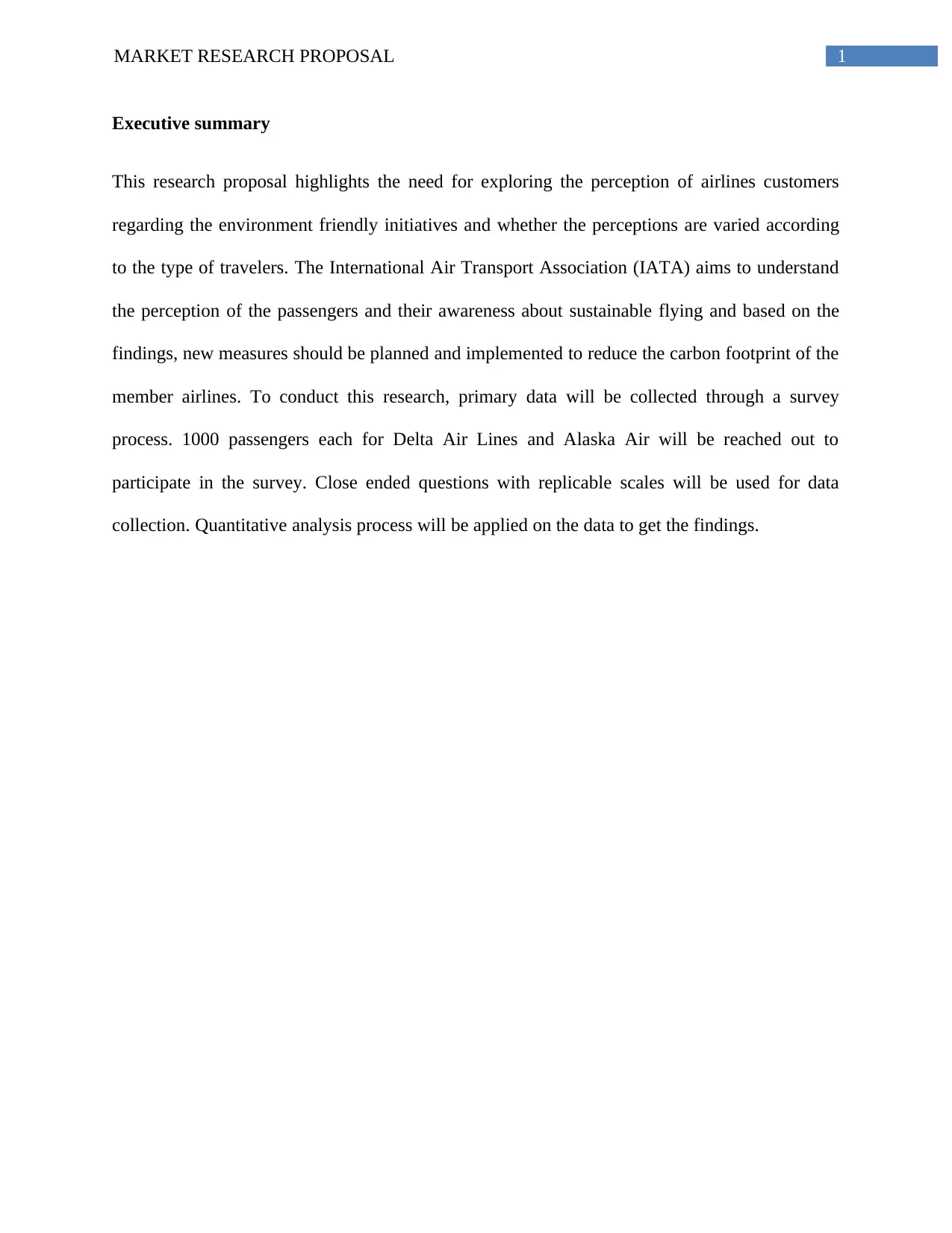
1MARKET RESEARCH PROPOSAL
Executive summary
This research proposal highlights the need for exploring the perception of airlines customers
regarding the environment friendly initiatives and whether the perceptions are varied according
to the type of travelers. The International Air Transport Association (IATA) aims to understand
the perception of the passengers and their awareness about sustainable flying and based on the
findings, new measures should be planned and implemented to reduce the carbon footprint of the
member airlines. To conduct this research, primary data will be collected through a survey
process. 1000 passengers each for Delta Air Lines and Alaska Air will be reached out to
participate in the survey. Close ended questions with replicable scales will be used for data
collection. Quantitative analysis process will be applied on the data to get the findings.
Executive summary
This research proposal highlights the need for exploring the perception of airlines customers
regarding the environment friendly initiatives and whether the perceptions are varied according
to the type of travelers. The International Air Transport Association (IATA) aims to understand
the perception of the passengers and their awareness about sustainable flying and based on the
findings, new measures should be planned and implemented to reduce the carbon footprint of the
member airlines. To conduct this research, primary data will be collected through a survey
process. 1000 passengers each for Delta Air Lines and Alaska Air will be reached out to
participate in the survey. Close ended questions with replicable scales will be used for data
collection. Quantitative analysis process will be applied on the data to get the findings.
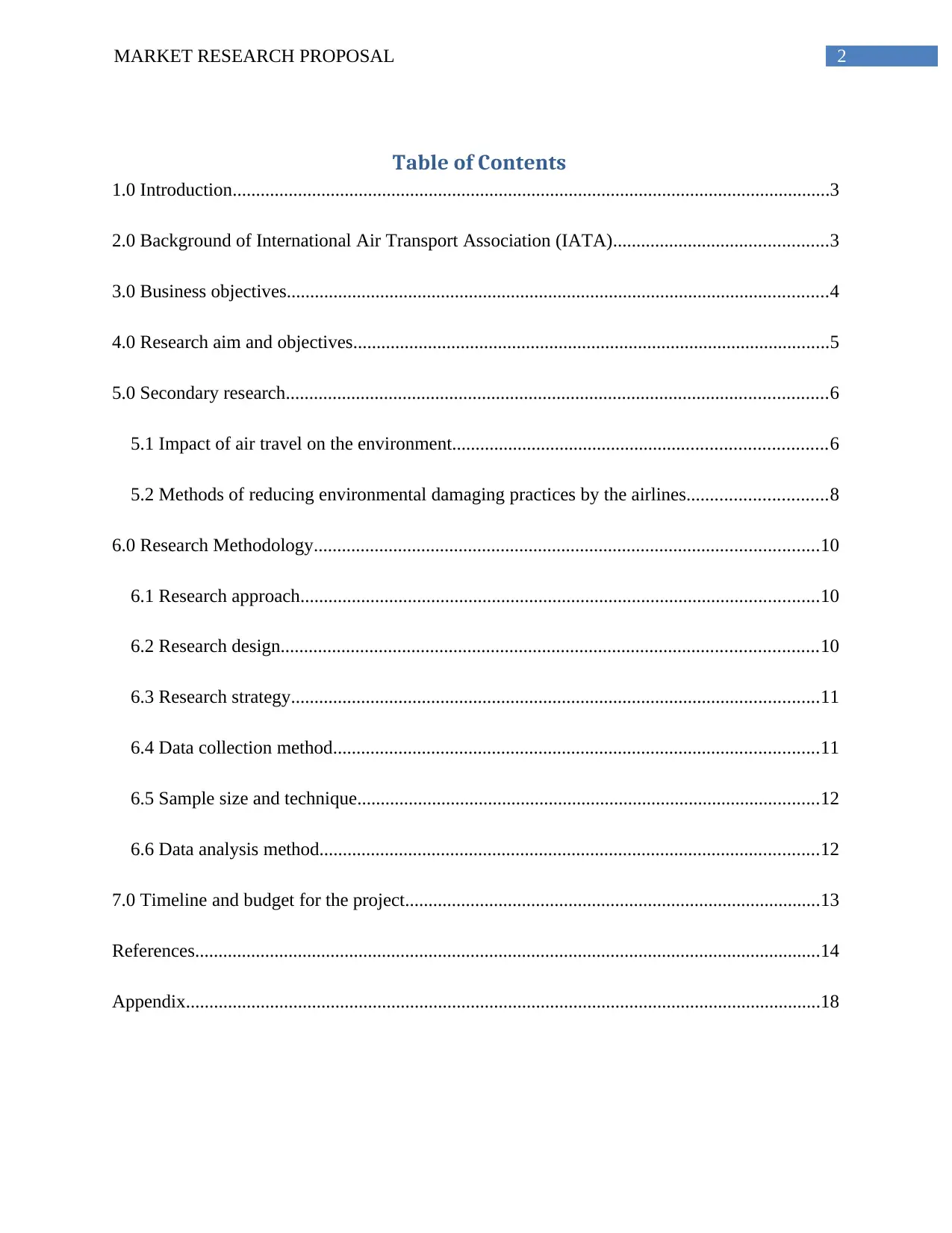
2MARKET RESEARCH PROPOSAL
Table of Contents
1.0 Introduction................................................................................................................................3
2.0 Background of International Air Transport Association (IATA)..............................................3
3.0 Business objectives....................................................................................................................4
4.0 Research aim and objectives......................................................................................................5
5.0 Secondary research....................................................................................................................6
5.1 Impact of air travel on the environment................................................................................6
5.2 Methods of reducing environmental damaging practices by the airlines..............................8
6.0 Research Methodology............................................................................................................10
6.1 Research approach...............................................................................................................10
6.2 Research design...................................................................................................................10
6.3 Research strategy.................................................................................................................11
6.4 Data collection method........................................................................................................11
6.5 Sample size and technique...................................................................................................12
6.6 Data analysis method...........................................................................................................12
7.0 Timeline and budget for the project.........................................................................................13
References......................................................................................................................................14
Appendix........................................................................................................................................18
Table of Contents
1.0 Introduction................................................................................................................................3
2.0 Background of International Air Transport Association (IATA)..............................................3
3.0 Business objectives....................................................................................................................4
4.0 Research aim and objectives......................................................................................................5
5.0 Secondary research....................................................................................................................6
5.1 Impact of air travel on the environment................................................................................6
5.2 Methods of reducing environmental damaging practices by the airlines..............................8
6.0 Research Methodology............................................................................................................10
6.1 Research approach...............................................................................................................10
6.2 Research design...................................................................................................................10
6.3 Research strategy.................................................................................................................11
6.4 Data collection method........................................................................................................11
6.5 Sample size and technique...................................................................................................12
6.6 Data analysis method...........................................................................................................12
7.0 Timeline and budget for the project.........................................................................................13
References......................................................................................................................................14
Appendix........................................................................................................................................18
⊘ This is a preview!⊘
Do you want full access?
Subscribe today to unlock all pages.

Trusted by 1+ million students worldwide

3MARKET RESEARCH PROPOSAL
Paraphrase This Document
Need a fresh take? Get an instant paraphrase of this document with our AI Paraphraser
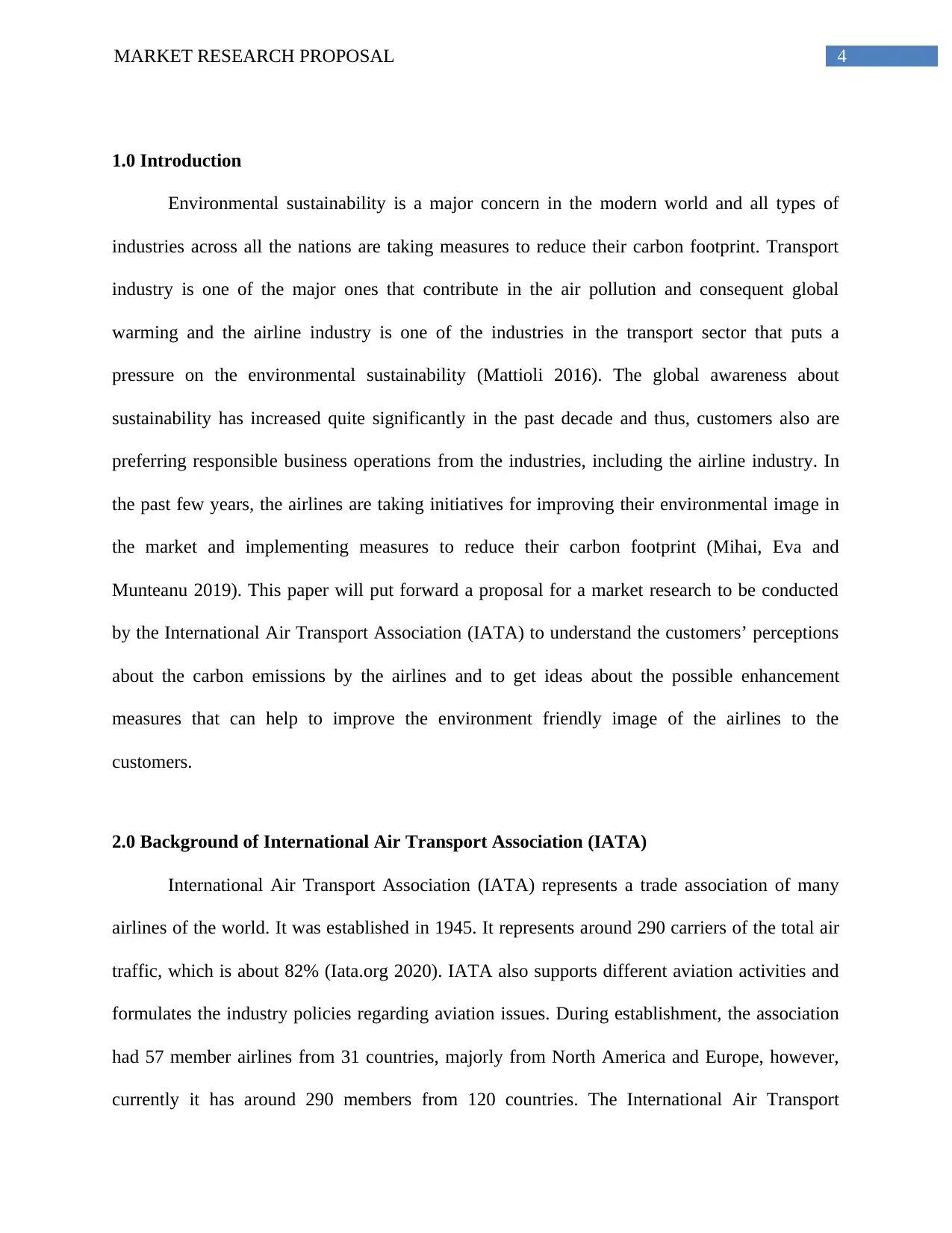
4MARKET RESEARCH PROPOSAL
1.0 Introduction
Environmental sustainability is a major concern in the modern world and all types of
industries across all the nations are taking measures to reduce their carbon footprint. Transport
industry is one of the major ones that contribute in the air pollution and consequent global
warming and the airline industry is one of the industries in the transport sector that puts a
pressure on the environmental sustainability (Mattioli 2016). The global awareness about
sustainability has increased quite significantly in the past decade and thus, customers also are
preferring responsible business operations from the industries, including the airline industry. In
the past few years, the airlines are taking initiatives for improving their environmental image in
the market and implementing measures to reduce their carbon footprint (Mihai, Eva and
Munteanu 2019). This paper will put forward a proposal for a market research to be conducted
by the International Air Transport Association (IATA) to understand the customers’ perceptions
about the carbon emissions by the airlines and to get ideas about the possible enhancement
measures that can help to improve the environment friendly image of the airlines to the
customers.
2.0 Background of International Air Transport Association (IATA)
International Air Transport Association (IATA) represents a trade association of many
airlines of the world. It was established in 1945. It represents around 290 carriers of the total air
traffic, which is about 82% (Iata.org 2020). IATA also supports different aviation activities and
formulates the industry policies regarding aviation issues. During establishment, the association
had 57 member airlines from 31 countries, majorly from North America and Europe, however,
currently it has around 290 members from 120 countries. The International Air Transport
1.0 Introduction
Environmental sustainability is a major concern in the modern world and all types of
industries across all the nations are taking measures to reduce their carbon footprint. Transport
industry is one of the major ones that contribute in the air pollution and consequent global
warming and the airline industry is one of the industries in the transport sector that puts a
pressure on the environmental sustainability (Mattioli 2016). The global awareness about
sustainability has increased quite significantly in the past decade and thus, customers also are
preferring responsible business operations from the industries, including the airline industry. In
the past few years, the airlines are taking initiatives for improving their environmental image in
the market and implementing measures to reduce their carbon footprint (Mihai, Eva and
Munteanu 2019). This paper will put forward a proposal for a market research to be conducted
by the International Air Transport Association (IATA) to understand the customers’ perceptions
about the carbon emissions by the airlines and to get ideas about the possible enhancement
measures that can help to improve the environment friendly image of the airlines to the
customers.
2.0 Background of International Air Transport Association (IATA)
International Air Transport Association (IATA) represents a trade association of many
airlines of the world. It was established in 1945. It represents around 290 carriers of the total air
traffic, which is about 82% (Iata.org 2020). IATA also supports different aviation activities and
formulates the industry policies regarding aviation issues. During establishment, the association
had 57 member airlines from 31 countries, majorly from North America and Europe, however,
currently it has around 290 members from 120 countries. The International Air Transport
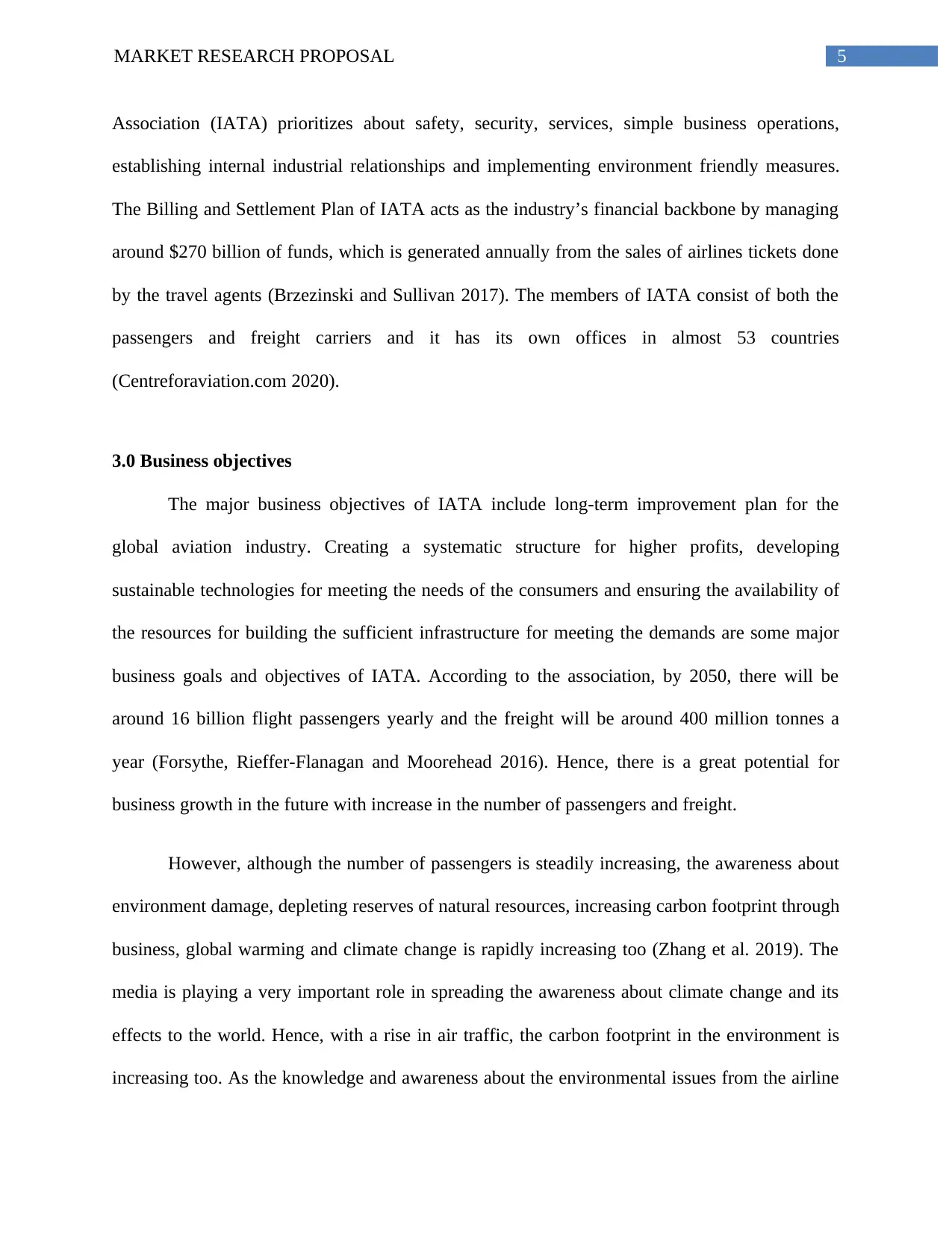
5MARKET RESEARCH PROPOSAL
Association (IATA) prioritizes about safety, security, services, simple business operations,
establishing internal industrial relationships and implementing environment friendly measures.
The Billing and Settlement Plan of IATA acts as the industry’s financial backbone by managing
around $270 billion of funds, which is generated annually from the sales of airlines tickets done
by the travel agents (Brzezinski and Sullivan 2017). The members of IATA consist of both the
passengers and freight carriers and it has its own offices in almost 53 countries
(Centreforaviation.com 2020).
3.0 Business objectives
The major business objectives of IATA include long-term improvement plan for the
global aviation industry. Creating a systematic structure for higher profits, developing
sustainable technologies for meeting the needs of the consumers and ensuring the availability of
the resources for building the sufficient infrastructure for meeting the demands are some major
business goals and objectives of IATA. According to the association, by 2050, there will be
around 16 billion flight passengers yearly and the freight will be around 400 million tonnes a
year (Forsythe, Rieffer-Flanagan and Moorehead 2016). Hence, there is a great potential for
business growth in the future with increase in the number of passengers and freight.
However, although the number of passengers is steadily increasing, the awareness about
environment damage, depleting reserves of natural resources, increasing carbon footprint through
business, global warming and climate change is rapidly increasing too (Zhang et al. 2019). The
media is playing a very important role in spreading the awareness about climate change and its
effects to the world. Hence, with a rise in air traffic, the carbon footprint in the environment is
increasing too. As the knowledge and awareness about the environmental issues from the airline
Association (IATA) prioritizes about safety, security, services, simple business operations,
establishing internal industrial relationships and implementing environment friendly measures.
The Billing and Settlement Plan of IATA acts as the industry’s financial backbone by managing
around $270 billion of funds, which is generated annually from the sales of airlines tickets done
by the travel agents (Brzezinski and Sullivan 2017). The members of IATA consist of both the
passengers and freight carriers and it has its own offices in almost 53 countries
(Centreforaviation.com 2020).
3.0 Business objectives
The major business objectives of IATA include long-term improvement plan for the
global aviation industry. Creating a systematic structure for higher profits, developing
sustainable technologies for meeting the needs of the consumers and ensuring the availability of
the resources for building the sufficient infrastructure for meeting the demands are some major
business goals and objectives of IATA. According to the association, by 2050, there will be
around 16 billion flight passengers yearly and the freight will be around 400 million tonnes a
year (Forsythe, Rieffer-Flanagan and Moorehead 2016). Hence, there is a great potential for
business growth in the future with increase in the number of passengers and freight.
However, although the number of passengers is steadily increasing, the awareness about
environment damage, depleting reserves of natural resources, increasing carbon footprint through
business, global warming and climate change is rapidly increasing too (Zhang et al. 2019). The
media is playing a very important role in spreading the awareness about climate change and its
effects to the world. Hence, with a rise in air traffic, the carbon footprint in the environment is
increasing too. As the knowledge and awareness about the environmental issues from the airline
⊘ This is a preview!⊘
Do you want full access?
Subscribe today to unlock all pages.

Trusted by 1+ million students worldwide
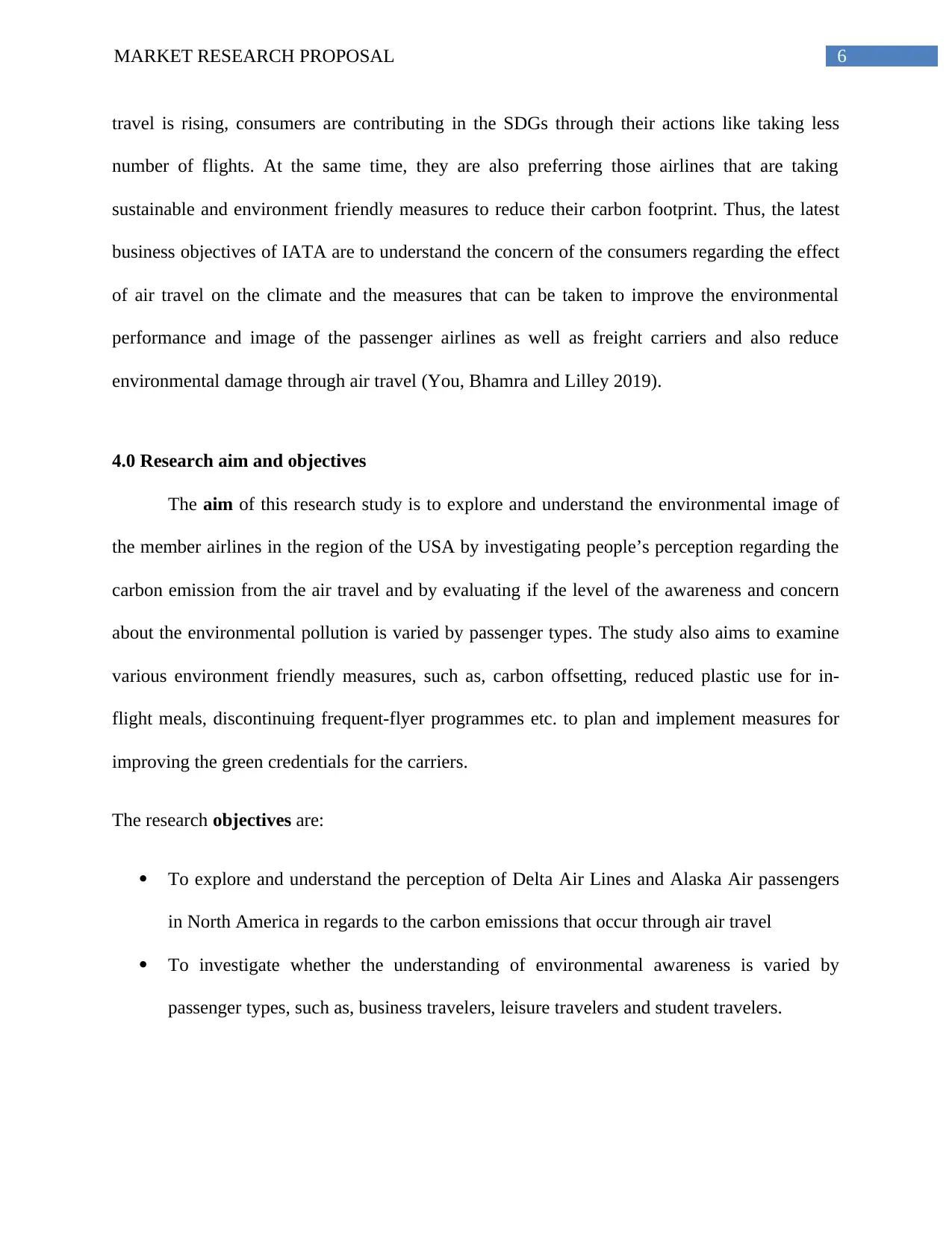
6MARKET RESEARCH PROPOSAL
travel is rising, consumers are contributing in the SDGs through their actions like taking less
number of flights. At the same time, they are also preferring those airlines that are taking
sustainable and environment friendly measures to reduce their carbon footprint. Thus, the latest
business objectives of IATA are to understand the concern of the consumers regarding the effect
of air travel on the climate and the measures that can be taken to improve the environmental
performance and image of the passenger airlines as well as freight carriers and also reduce
environmental damage through air travel (You, Bhamra and Lilley 2019).
4.0 Research aim and objectives
The aim of this research study is to explore and understand the environmental image of
the member airlines in the region of the USA by investigating people’s perception regarding the
carbon emission from the air travel and by evaluating if the level of the awareness and concern
about the environmental pollution is varied by passenger types. The study also aims to examine
various environment friendly measures, such as, carbon offsetting, reduced plastic use for in-
flight meals, discontinuing frequent-flyer programmes etc. to plan and implement measures for
improving the green credentials for the carriers.
The research objectives are:
To explore and understand the perception of Delta Air Lines and Alaska Air passengers
in North America in regards to the carbon emissions that occur through air travel
To investigate whether the understanding of environmental awareness is varied by
passenger types, such as, business travelers, leisure travelers and student travelers.
travel is rising, consumers are contributing in the SDGs through their actions like taking less
number of flights. At the same time, they are also preferring those airlines that are taking
sustainable and environment friendly measures to reduce their carbon footprint. Thus, the latest
business objectives of IATA are to understand the concern of the consumers regarding the effect
of air travel on the climate and the measures that can be taken to improve the environmental
performance and image of the passenger airlines as well as freight carriers and also reduce
environmental damage through air travel (You, Bhamra and Lilley 2019).
4.0 Research aim and objectives
The aim of this research study is to explore and understand the environmental image of
the member airlines in the region of the USA by investigating people’s perception regarding the
carbon emission from the air travel and by evaluating if the level of the awareness and concern
about the environmental pollution is varied by passenger types. The study also aims to examine
various environment friendly measures, such as, carbon offsetting, reduced plastic use for in-
flight meals, discontinuing frequent-flyer programmes etc. to plan and implement measures for
improving the green credentials for the carriers.
The research objectives are:
To explore and understand the perception of Delta Air Lines and Alaska Air passengers
in North America in regards to the carbon emissions that occur through air travel
To investigate whether the understanding of environmental awareness is varied by
passenger types, such as, business travelers, leisure travelers and student travelers.
Paraphrase This Document
Need a fresh take? Get an instant paraphrase of this document with our AI Paraphraser
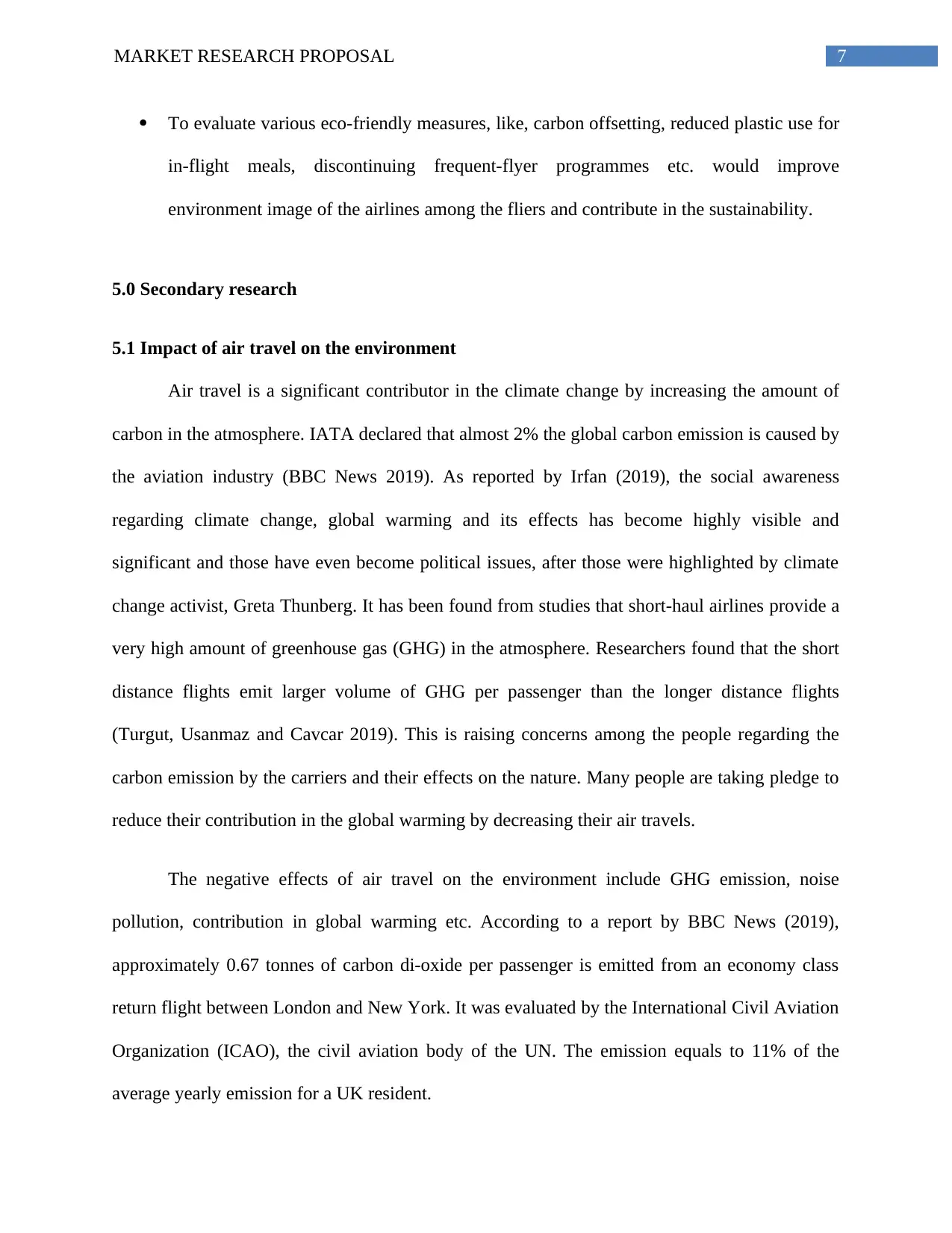
7MARKET RESEARCH PROPOSAL
To evaluate various eco-friendly measures, like, carbon offsetting, reduced plastic use for
in-flight meals, discontinuing frequent-flyer programmes etc. would improve
environment image of the airlines among the fliers and contribute in the sustainability.
5.0 Secondary research
5.1 Impact of air travel on the environment
Air travel is a significant contributor in the climate change by increasing the amount of
carbon in the atmosphere. IATA declared that almost 2% the global carbon emission is caused by
the aviation industry (BBC News 2019). As reported by Irfan (2019), the social awareness
regarding climate change, global warming and its effects has become highly visible and
significant and those have even become political issues, after those were highlighted by climate
change activist, Greta Thunberg. It has been found from studies that short-haul airlines provide a
very high amount of greenhouse gas (GHG) in the atmosphere. Researchers found that the short
distance flights emit larger volume of GHG per passenger than the longer distance flights
(Turgut, Usanmaz and Cavcar 2019). This is raising concerns among the people regarding the
carbon emission by the carriers and their effects on the nature. Many people are taking pledge to
reduce their contribution in the global warming by decreasing their air travels.
The negative effects of air travel on the environment include GHG emission, noise
pollution, contribution in global warming etc. According to a report by BBC News (2019),
approximately 0.67 tonnes of carbon di-oxide per passenger is emitted from an economy class
return flight between London and New York. It was evaluated by the International Civil Aviation
Organization (ICAO), the civil aviation body of the UN. The emission equals to 11% of the
average yearly emission for a UK resident.
To evaluate various eco-friendly measures, like, carbon offsetting, reduced plastic use for
in-flight meals, discontinuing frequent-flyer programmes etc. would improve
environment image of the airlines among the fliers and contribute in the sustainability.
5.0 Secondary research
5.1 Impact of air travel on the environment
Air travel is a significant contributor in the climate change by increasing the amount of
carbon in the atmosphere. IATA declared that almost 2% the global carbon emission is caused by
the aviation industry (BBC News 2019). As reported by Irfan (2019), the social awareness
regarding climate change, global warming and its effects has become highly visible and
significant and those have even become political issues, after those were highlighted by climate
change activist, Greta Thunberg. It has been found from studies that short-haul airlines provide a
very high amount of greenhouse gas (GHG) in the atmosphere. Researchers found that the short
distance flights emit larger volume of GHG per passenger than the longer distance flights
(Turgut, Usanmaz and Cavcar 2019). This is raising concerns among the people regarding the
carbon emission by the carriers and their effects on the nature. Many people are taking pledge to
reduce their contribution in the global warming by decreasing their air travels.
The negative effects of air travel on the environment include GHG emission, noise
pollution, contribution in global warming etc. According to a report by BBC News (2019),
approximately 0.67 tonnes of carbon di-oxide per passenger is emitted from an economy class
return flight between London and New York. It was evaluated by the International Civil Aviation
Organization (ICAO), the civil aviation body of the UN. The emission equals to 11% of the
average yearly emission for a UK resident.
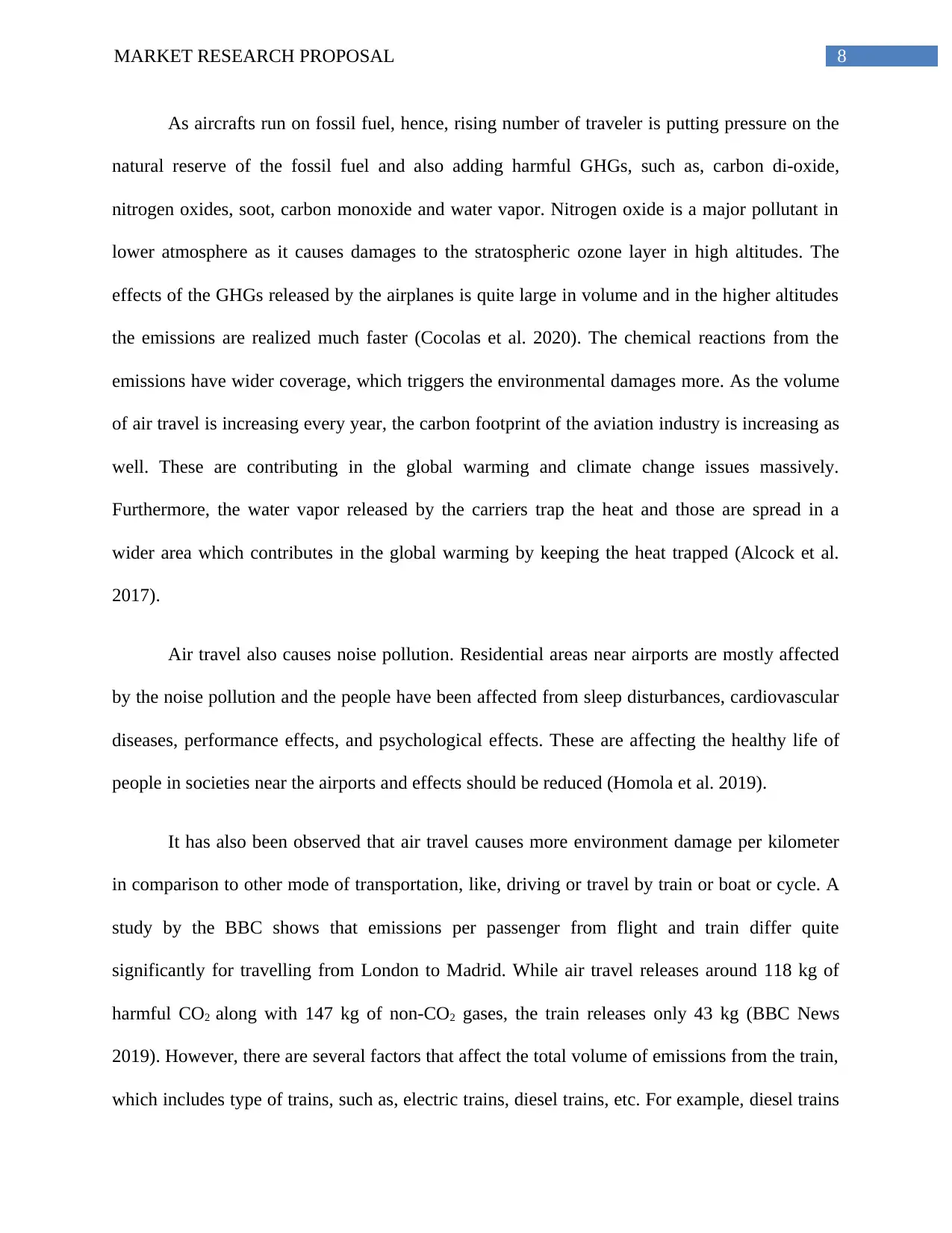
8MARKET RESEARCH PROPOSAL
As aircrafts run on fossil fuel, hence, rising number of traveler is putting pressure on the
natural reserve of the fossil fuel and also adding harmful GHGs, such as, carbon di-oxide,
nitrogen oxides, soot, carbon monoxide and water vapor. Nitrogen oxide is a major pollutant in
lower atmosphere as it causes damages to the stratospheric ozone layer in high altitudes. The
effects of the GHGs released by the airplanes is quite large in volume and in the higher altitudes
the emissions are realized much faster (Cocolas et al. 2020). The chemical reactions from the
emissions have wider coverage, which triggers the environmental damages more. As the volume
of air travel is increasing every year, the carbon footprint of the aviation industry is increasing as
well. These are contributing in the global warming and climate change issues massively.
Furthermore, the water vapor released by the carriers trap the heat and those are spread in a
wider area which contributes in the global warming by keeping the heat trapped (Alcock et al.
2017).
Air travel also causes noise pollution. Residential areas near airports are mostly affected
by the noise pollution and the people have been affected from sleep disturbances, cardiovascular
diseases, performance effects, and psychological effects. These are affecting the healthy life of
people in societies near the airports and effects should be reduced (Homola et al. 2019).
It has also been observed that air travel causes more environment damage per kilometer
in comparison to other mode of transportation, like, driving or travel by train or boat or cycle. A
study by the BBC shows that emissions per passenger from flight and train differ quite
significantly for travelling from London to Madrid. While air travel releases around 118 kg of
harmful CO2 along with 147 kg of non-CO2 gases, the train releases only 43 kg (BBC News
2019). However, there are several factors that affect the total volume of emissions from the train,
which includes type of trains, such as, electric trains, diesel trains, etc. For example, diesel trains
As aircrafts run on fossil fuel, hence, rising number of traveler is putting pressure on the
natural reserve of the fossil fuel and also adding harmful GHGs, such as, carbon di-oxide,
nitrogen oxides, soot, carbon monoxide and water vapor. Nitrogen oxide is a major pollutant in
lower atmosphere as it causes damages to the stratospheric ozone layer in high altitudes. The
effects of the GHGs released by the airplanes is quite large in volume and in the higher altitudes
the emissions are realized much faster (Cocolas et al. 2020). The chemical reactions from the
emissions have wider coverage, which triggers the environmental damages more. As the volume
of air travel is increasing every year, the carbon footprint of the aviation industry is increasing as
well. These are contributing in the global warming and climate change issues massively.
Furthermore, the water vapor released by the carriers trap the heat and those are spread in a
wider area which contributes in the global warming by keeping the heat trapped (Alcock et al.
2017).
Air travel also causes noise pollution. Residential areas near airports are mostly affected
by the noise pollution and the people have been affected from sleep disturbances, cardiovascular
diseases, performance effects, and psychological effects. These are affecting the healthy life of
people in societies near the airports and effects should be reduced (Homola et al. 2019).
It has also been observed that air travel causes more environment damage per kilometer
in comparison to other mode of transportation, like, driving or travel by train or boat or cycle. A
study by the BBC shows that emissions per passenger from flight and train differ quite
significantly for travelling from London to Madrid. While air travel releases around 118 kg of
harmful CO2 along with 147 kg of non-CO2 gases, the train releases only 43 kg (BBC News
2019). However, there are several factors that affect the total volume of emissions from the train,
which includes type of trains, such as, electric trains, diesel trains, etc. For example, diesel trains
⊘ This is a preview!⊘
Do you want full access?
Subscribe today to unlock all pages.

Trusted by 1+ million students worldwide
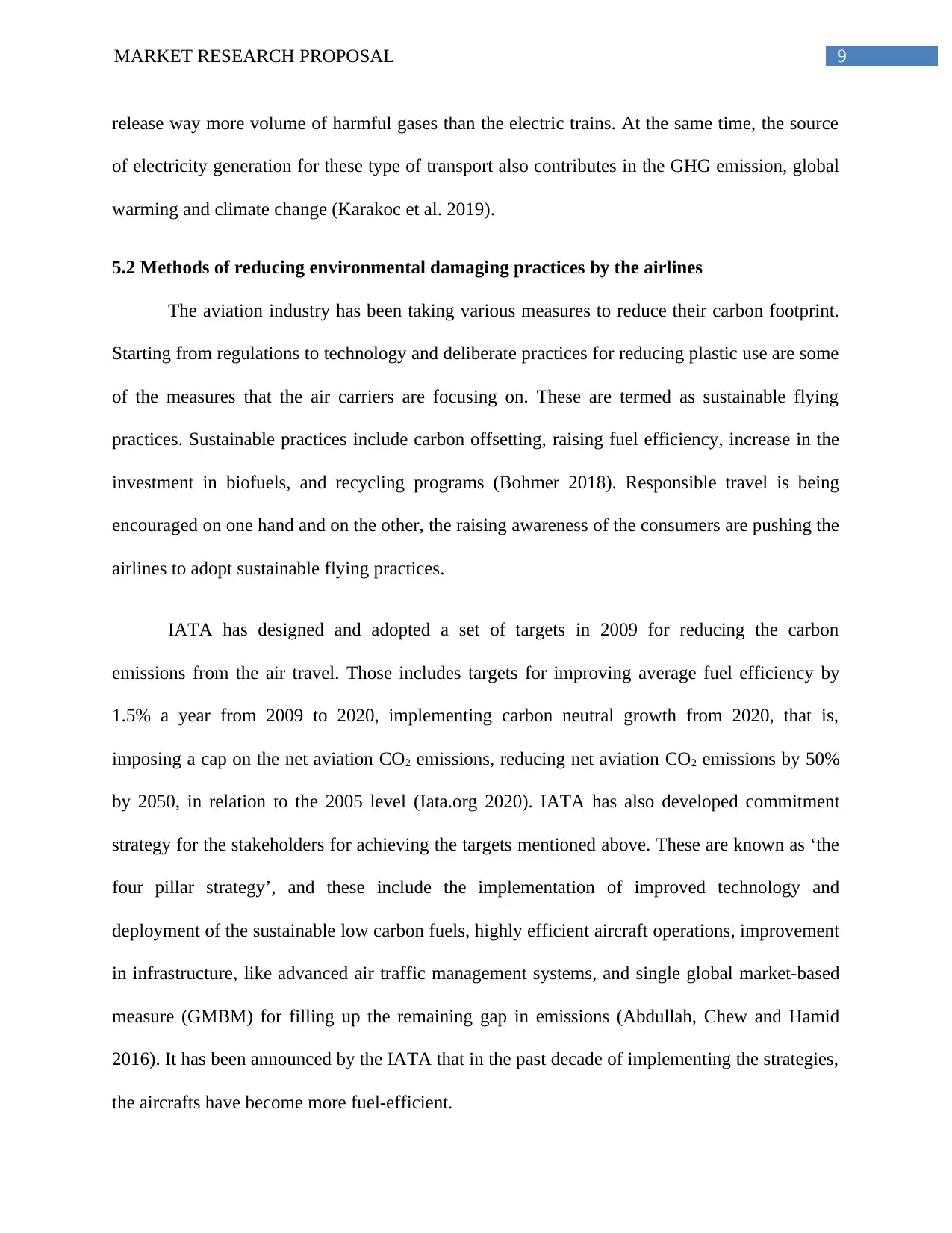
9MARKET RESEARCH PROPOSAL
release way more volume of harmful gases than the electric trains. At the same time, the source
of electricity generation for these type of transport also contributes in the GHG emission, global
warming and climate change (Karakoc et al. 2019).
5.2 Methods of reducing environmental damaging practices by the airlines
The aviation industry has been taking various measures to reduce their carbon footprint.
Starting from regulations to technology and deliberate practices for reducing plastic use are some
of the measures that the air carriers are focusing on. These are termed as sustainable flying
practices. Sustainable practices include carbon offsetting, raising fuel efficiency, increase in the
investment in biofuels, and recycling programs (Bohmer 2018). Responsible travel is being
encouraged on one hand and on the other, the raising awareness of the consumers are pushing the
airlines to adopt sustainable flying practices.
IATA has designed and adopted a set of targets in 2009 for reducing the carbon
emissions from the air travel. Those includes targets for improving average fuel efficiency by
1.5% a year from 2009 to 2020, implementing carbon neutral growth from 2020, that is,
imposing a cap on the net aviation CO2 emissions, reducing net aviation CO2 emissions by 50%
by 2050, in relation to the 2005 level (Iata.org 2020). IATA has also developed commitment
strategy for the stakeholders for achieving the targets mentioned above. These are known as ‘the
four pillar strategy’, and these include the implementation of improved technology and
deployment of the sustainable low carbon fuels, highly efficient aircraft operations, improvement
in infrastructure, like advanced air traffic management systems, and single global market-based
measure (GMBM) for filling up the remaining gap in emissions (Abdullah, Chew and Hamid
2016). It has been announced by the IATA that in the past decade of implementing the strategies,
the aircrafts have become more fuel-efficient.
release way more volume of harmful gases than the electric trains. At the same time, the source
of electricity generation for these type of transport also contributes in the GHG emission, global
warming and climate change (Karakoc et al. 2019).
5.2 Methods of reducing environmental damaging practices by the airlines
The aviation industry has been taking various measures to reduce their carbon footprint.
Starting from regulations to technology and deliberate practices for reducing plastic use are some
of the measures that the air carriers are focusing on. These are termed as sustainable flying
practices. Sustainable practices include carbon offsetting, raising fuel efficiency, increase in the
investment in biofuels, and recycling programs (Bohmer 2018). Responsible travel is being
encouraged on one hand and on the other, the raising awareness of the consumers are pushing the
airlines to adopt sustainable flying practices.
IATA has designed and adopted a set of targets in 2009 for reducing the carbon
emissions from the air travel. Those includes targets for improving average fuel efficiency by
1.5% a year from 2009 to 2020, implementing carbon neutral growth from 2020, that is,
imposing a cap on the net aviation CO2 emissions, reducing net aviation CO2 emissions by 50%
by 2050, in relation to the 2005 level (Iata.org 2020). IATA has also developed commitment
strategy for the stakeholders for achieving the targets mentioned above. These are known as ‘the
four pillar strategy’, and these include the implementation of improved technology and
deployment of the sustainable low carbon fuels, highly efficient aircraft operations, improvement
in infrastructure, like advanced air traffic management systems, and single global market-based
measure (GMBM) for filling up the remaining gap in emissions (Abdullah, Chew and Hamid
2016). It has been announced by the IATA that in the past decade of implementing the strategies,
the aircrafts have become more fuel-efficient.
Paraphrase This Document
Need a fresh take? Get an instant paraphrase of this document with our AI Paraphraser
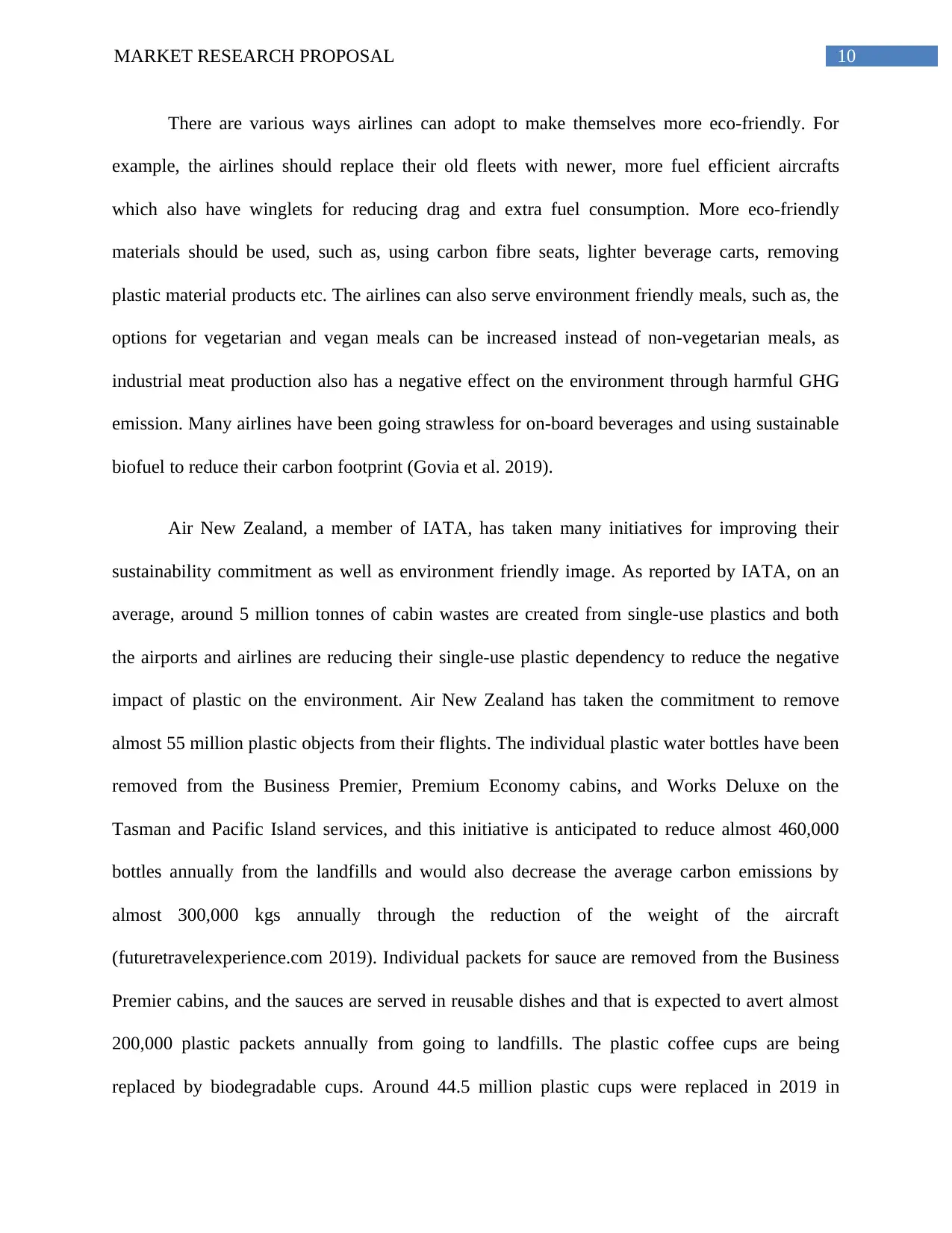
10MARKET RESEARCH PROPOSAL
There are various ways airlines can adopt to make themselves more eco-friendly. For
example, the airlines should replace their old fleets with newer, more fuel efficient aircrafts
which also have winglets for reducing drag and extra fuel consumption. More eco-friendly
materials should be used, such as, using carbon fibre seats, lighter beverage carts, removing
plastic material products etc. The airlines can also serve environment friendly meals, such as, the
options for vegetarian and vegan meals can be increased instead of non-vegetarian meals, as
industrial meat production also has a negative effect on the environment through harmful GHG
emission. Many airlines have been going strawless for on-board beverages and using sustainable
biofuel to reduce their carbon footprint (Govia et al. 2019).
Air New Zealand, a member of IATA, has taken many initiatives for improving their
sustainability commitment as well as environment friendly image. As reported by IATA, on an
average, around 5 million tonnes of cabin wastes are created from single-use plastics and both
the airports and airlines are reducing their single-use plastic dependency to reduce the negative
impact of plastic on the environment. Air New Zealand has taken the commitment to remove
almost 55 million plastic objects from their flights. The individual plastic water bottles have been
removed from the Business Premier, Premium Economy cabins, and Works Deluxe on the
Tasman and Pacific Island services, and this initiative is anticipated to reduce almost 460,000
bottles annually from the landfills and would also decrease the average carbon emissions by
almost 300,000 kgs annually through the reduction of the weight of the aircraft
(futuretravelexperience.com 2019). Individual packets for sauce are removed from the Business
Premier cabins, and the sauces are served in reusable dishes and that is expected to avert almost
200,000 plastic packets annually from going to landfills. The plastic coffee cups are being
replaced by biodegradable cups. Around 44.5 million plastic cups were replaced in 2019 in
There are various ways airlines can adopt to make themselves more eco-friendly. For
example, the airlines should replace their old fleets with newer, more fuel efficient aircrafts
which also have winglets for reducing drag and extra fuel consumption. More eco-friendly
materials should be used, such as, using carbon fibre seats, lighter beverage carts, removing
plastic material products etc. The airlines can also serve environment friendly meals, such as, the
options for vegetarian and vegan meals can be increased instead of non-vegetarian meals, as
industrial meat production also has a negative effect on the environment through harmful GHG
emission. Many airlines have been going strawless for on-board beverages and using sustainable
biofuel to reduce their carbon footprint (Govia et al. 2019).
Air New Zealand, a member of IATA, has taken many initiatives for improving their
sustainability commitment as well as environment friendly image. As reported by IATA, on an
average, around 5 million tonnes of cabin wastes are created from single-use plastics and both
the airports and airlines are reducing their single-use plastic dependency to reduce the negative
impact of plastic on the environment. Air New Zealand has taken the commitment to remove
almost 55 million plastic objects from their flights. The individual plastic water bottles have been
removed from the Business Premier, Premium Economy cabins, and Works Deluxe on the
Tasman and Pacific Island services, and this initiative is anticipated to reduce almost 460,000
bottles annually from the landfills and would also decrease the average carbon emissions by
almost 300,000 kgs annually through the reduction of the weight of the aircraft
(futuretravelexperience.com 2019). Individual packets for sauce are removed from the Business
Premier cabins, and the sauces are served in reusable dishes and that is expected to avert almost
200,000 plastic packets annually from going to landfills. The plastic coffee cups are being
replaced by biodegradable cups. Around 44.5 million plastic cups were replaced in 2019 in
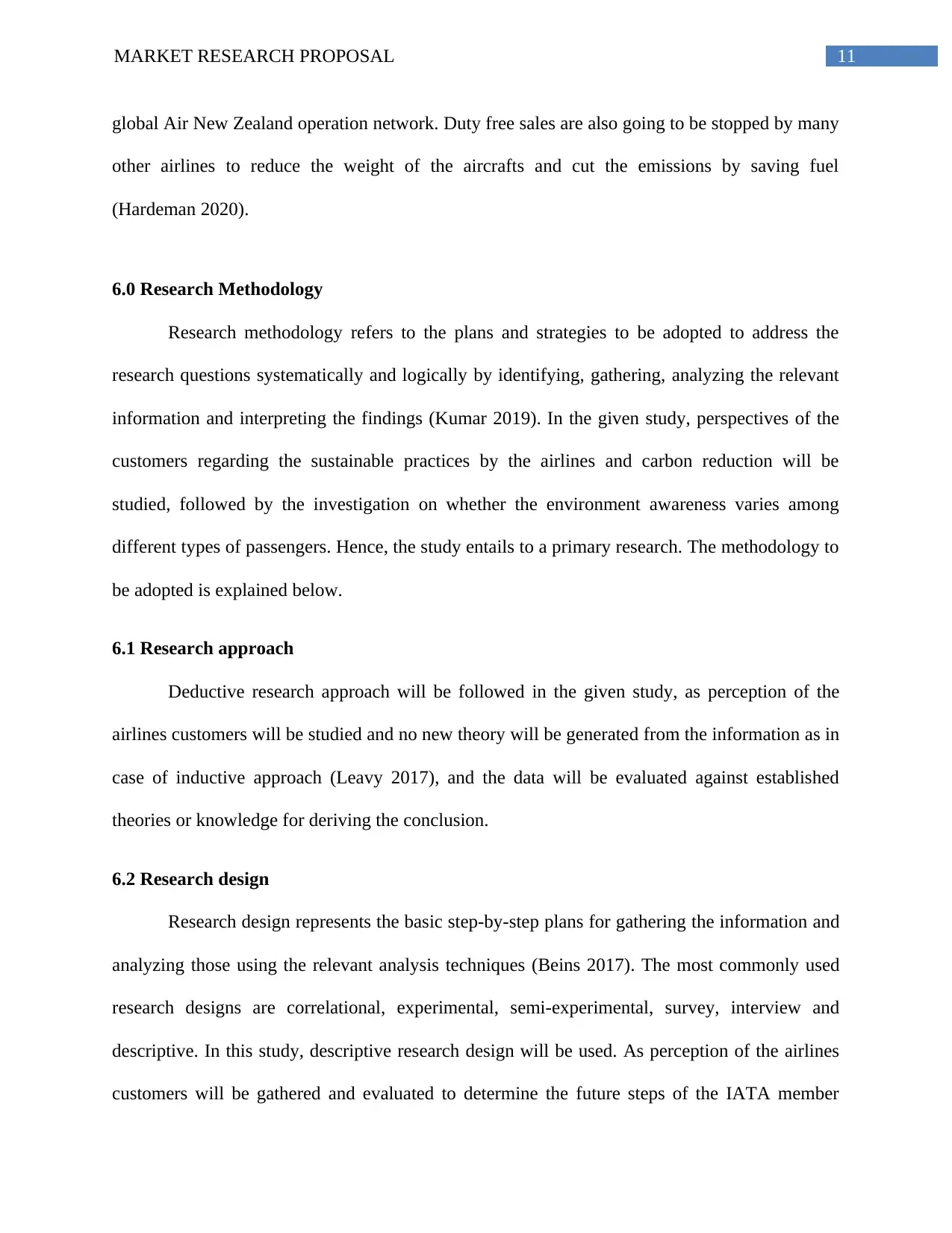
11MARKET RESEARCH PROPOSAL
global Air New Zealand operation network. Duty free sales are also going to be stopped by many
other airlines to reduce the weight of the aircrafts and cut the emissions by saving fuel
(Hardeman 2020).
6.0 Research Methodology
Research methodology refers to the plans and strategies to be adopted to address the
research questions systematically and logically by identifying, gathering, analyzing the relevant
information and interpreting the findings (Kumar 2019). In the given study, perspectives of the
customers regarding the sustainable practices by the airlines and carbon reduction will be
studied, followed by the investigation on whether the environment awareness varies among
different types of passengers. Hence, the study entails to a primary research. The methodology to
be adopted is explained below.
6.1 Research approach
Deductive research approach will be followed in the given study, as perception of the
airlines customers will be studied and no new theory will be generated from the information as in
case of inductive approach (Leavy 2017), and the data will be evaluated against established
theories or knowledge for deriving the conclusion.
6.2 Research design
Research design represents the basic step-by-step plans for gathering the information and
analyzing those using the relevant analysis techniques (Beins 2017). The most commonly used
research designs are correlational, experimental, semi-experimental, survey, interview and
descriptive. In this study, descriptive research design will be used. As perception of the airlines
customers will be gathered and evaluated to determine the future steps of the IATA member
global Air New Zealand operation network. Duty free sales are also going to be stopped by many
other airlines to reduce the weight of the aircrafts and cut the emissions by saving fuel
(Hardeman 2020).
6.0 Research Methodology
Research methodology refers to the plans and strategies to be adopted to address the
research questions systematically and logically by identifying, gathering, analyzing the relevant
information and interpreting the findings (Kumar 2019). In the given study, perspectives of the
customers regarding the sustainable practices by the airlines and carbon reduction will be
studied, followed by the investigation on whether the environment awareness varies among
different types of passengers. Hence, the study entails to a primary research. The methodology to
be adopted is explained below.
6.1 Research approach
Deductive research approach will be followed in the given study, as perception of the
airlines customers will be studied and no new theory will be generated from the information as in
case of inductive approach (Leavy 2017), and the data will be evaluated against established
theories or knowledge for deriving the conclusion.
6.2 Research design
Research design represents the basic step-by-step plans for gathering the information and
analyzing those using the relevant analysis techniques (Beins 2017). The most commonly used
research designs are correlational, experimental, semi-experimental, survey, interview and
descriptive. In this study, descriptive research design will be used. As perception of the airlines
customers will be gathered and evaluated to determine the future steps of the IATA member
⊘ This is a preview!⊘
Do you want full access?
Subscribe today to unlock all pages.

Trusted by 1+ million students worldwide
1 out of 22
Related Documents
Your All-in-One AI-Powered Toolkit for Academic Success.
+13062052269
info@desklib.com
Available 24*7 on WhatsApp / Email
![[object Object]](/_next/static/media/star-bottom.7253800d.svg)
Unlock your academic potential
Copyright © 2020–2025 A2Z Services. All Rights Reserved. Developed and managed by ZUCOL.





